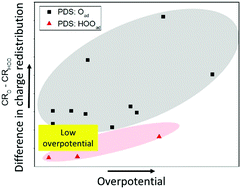The importance of charge redistribution during electrochemical reactions: a density functional theory study of silver orthophosphate (Ag3PO4)†
Abstract
The structural sensitivity of silver orthophosphate (Ag3PO4) for photo-electrochemical water oxidation on (100), (110) and (111) surfaces has recently been reported by experimental studies (D. J. Martin et al., Energy Environ. Sci., 2013, 6, 3380–3386). The (111) surface showed the highest performance with an oxygen evolution rate of 10 times higher than the other surfaces. The high performance of the (111) surface was attributed to high hole mobility, high surface energy and, in a recent theoretical study (Z. Ma et al., RSC Adv., 2017, 7, 23994–24003), to a lower OH adsorption energy and the band structure. The investigations are based on a few structures and a full atomistic picture of the Ag3PO4 under electrochemical reactions is still missing. Therefore, we report here a systematic study of the oxygen evolution reaction (OER) of Ag3PO4 (100), (110), and (111) surfaces by density functional theory (DFT) calculations. Through a detailed investigation of the reaction energies and the overpotentials of OER on all possible surface orientations with all possible terminations and different involvement of Ag adsorption sites, we can confirm that (111) surfaces are highly active. However, surface orientation was not found to exclusively determine the electrochemical activity; neither did the number of Ag atoms involved in the adsorption of the intermediate species nor the type of surface termination or the different potential determining reaction steps. By using Bader charge analysis and investigation of the charge redistribution during OER, we found that the highest activity, i.e. lowest overpotential, is related to the charge redistribution of two OER steps, namely the Oad and the HOOad formation. If the charge redistribution between these steps is small, then the overpotential is small and, hence, the activity is high. Charge redistributions are usually small for the (111) surface and therefore the (111) surface is usually the most active one. The concept of charge redistribution being decisive for the high activity of Ag3PO4 may open a new design strategy for materials with highly efficient electrochemical surfaces.



 Please wait while we load your content...
Please wait while we load your content...